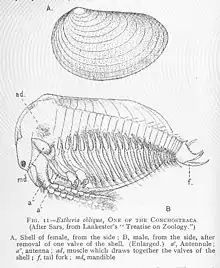Lioestheria
Lioestheria ('clam shrimp') are an extinct genus of crustaceans that thrived from the Carboniferous to the Cretaceous (360.7 to 99.7 Mya).[1] They fed on detritus, being very small slow moving, nektonic organisms that filter fed as they floated. They have been found in both marine and freshwater environments.[2]
| Lioestheria | |
|---|---|
 | |
| "Estheria" (Liostheria) obliqua | |
| Scientific classification | |
| Kingdom: | |
| Phylum: | |
| Subphylum: | |
| Class: | |
| Order: | |
| Family: | Lioestheriidae |
| Genus: | Lioestheria |
First identified in 1912,[3] they have been found in Germany,[4] Hungary, Colorado,[5] New Mexico, Montana, Texas [6] and China.[7]
References
- http://fossilworks.org/bridge.pl?a=taxonInfo&taxon_no=222093
- http://fossilworks.org/bridge.pl?a=taxonInfo&taxon_no=222093
- Depéret, Ch, and P. Mazeran. "Les Estheria du Permien d'Autun." Société d'Histoire Naturalle d'Autun, Bulletin 25 (1912): 165-174.
- D.S. Berman, S.S. Sumida, and T. Martens. 1998. Diadectes (Diadectomorpha: Diadectidae) from the Early Permian of Central Germany, with description of a new species. Annals of Carnegie Museum 67(1):53-93
- J. I. Kirkland and H. J. Armstrong. 1992. Taphonomy of the Mygatt-Moore (M&M) Quarry, middle Brushy Basin Member, Morrison Formation (Upper Jurassic) western Colorado. Journal of Vertebrate Paleontology 12(3, suppl.):55A
- P. Tasch. 1967. Conchostracans from the Lower Cretaceous (Albian) Paluxy Formation, Texas. 41(1):256-259 [J. Alroy/J. Alroy]
- Z. Q. Yao, J. T. Xu, Z. G. Zheng, X. H. Zhao, and Z. G. Mou. 1980. Late Permian Stratigraphy and Fossils in Western Guizhou and Eastern Yunnan 1-277
This article is issued from Wikipedia. The text is licensed under Creative Commons - Attribution - Sharealike. Additional terms may apply for the media files.